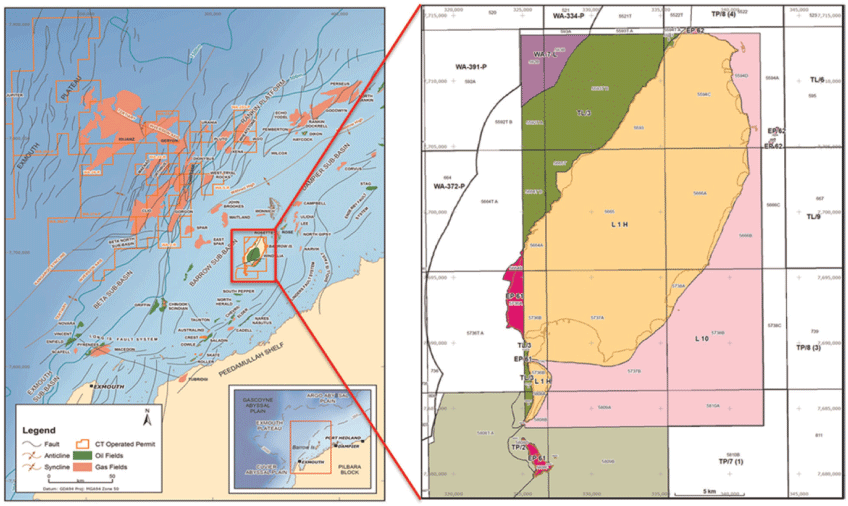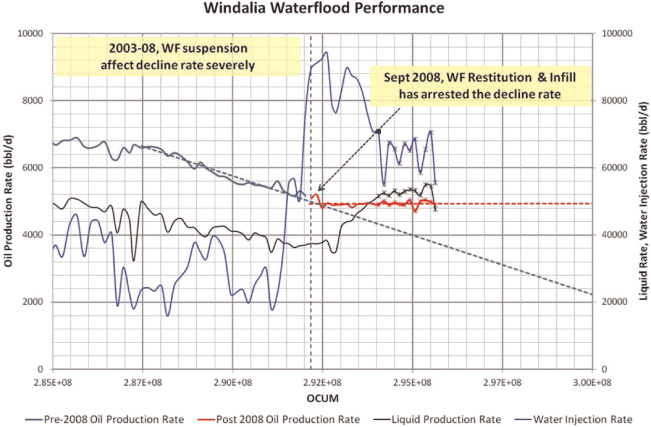The success story of Windalia waterflood optimisation through integrated asset management in a mature field*
L. Hartanto A , W. Widjanarko A and D. Muna AChevron Australia Pty Ltd.
The APPEA Journal 51(2) 726-726 https://doi.org/10.1071/AJ10106
Published: 2011
Abstract
Australia’s Barrow Island Windalia reservoir—the nation’s largest onshore waterflood—was developed in the late 1960s. The Barrow Island oilfield is Chevron Australia’s only mature waterflood, comprising more than 220 active injectors. The injectors pressurise and increase oil recovery from the geologically complex, low-permeable and heterogeneous Windalia Sand Member. To date it is estimated that the value of waterflooding has effectively reduced the field decline rate from approximately 18 % per annum to less than 2 %—adding millions of barrels in recovery and years on to productive field life. In September of 2008, the Windalia Waterflood achieved full field restitution. This involved the replacement and commissioning of glass-reinforced epoxy injection flow lines, a ring-main network and produced water re-injection facilities. Significant challenges were overcome in the process of realising the restitution’s full potential. Several waterflood optimisation activities have now been executed to achieve oil uplift and to capitalise on Chevron Australia’s investment. Compounded with restitution, the activities have successfully achieved the asset objective of arresting field production decline. This paper highlights the challenges encountered by the waterflood team, providing insights and lessons learned in the dynamic and holistic nature of waterflood management. It also highlights the interplay of considerations and what is crucial to achieving optimum sweep efficiency and pressurisation.
Introduction
The Barrow Island Windalia reservoir (Fig. 1) was developed in the late;1960s and is the nation’s largest onshore waterflood and Chevron Australia’s only mature waterflood. It comprises more than 220 active injectors and 400 producers. The reservoir is geologically complex, with low permeability and significant heterogeneity.
In late 2008, full-field restitution of the Windalia waterflood was undertaken involving the replacement and commissioning of glass-reinforced epoxy (GRE) injection flow lines, a ring-main network and re-injection facilities for produced water. The project was driven by the identification of leaking carbon steel flowlines with the potential to impact the environment and compromise the network delivery pressure. The project aimed to deliver larger volumes of water for injection to increase pore volume while also providing the flexibility to pattern balance—the process of leveraging injectivity and preferentially allocating water in accordance with deemed value in a hydraulically connected injected system.
Significant challenges were overcome in the process of realising the restitution’s full potential. Several activities to optimise the waterflood have now been executed to capitalise on Chevron Australia’s investment and these have successfully achieved the objective of arresting the decline in field production. The rate of field decline has since reduced from approximately 18% to less than 2% per annum, adding millions of barrels in incremental recovery and years to the productive field life.
Challenges
Identification of the potential constraints on the restored network was the first step in addressing the significant challenges faced by the Waterflood team in achieving a sustained reduction in the rate of production decline.
A waterflood response model has been developed for the individual patterns to identify the response in oil production rate per unit of water injection. These response models reveal that the best method of allocating water injection is to preferentially support those patterns with high rate of oil production response per unit of water being injected, thereby cycling less water and maximising oil production.
Due to the low permeability of the Windalia Reservoir and to achieve the target pore volumes injected and pressurisation levels, the injection pressure used exceeds the formation’s parting pressure (∼995 psi), enabling water to flow through fractures to neighbouring producers. The response times across the patterns vary markedly due to the heterogeneity of the field and have been estimated to range between five months to five years. Injector-producer relationships are often difficult to establish, hence analysis was typically performed on a pattern level due to the absence of up-to-date reservoir pressures and sparse surveillance data. These indirect methods of analysis were often only indicative at best.
Post commissioning, it was identified that although the system was delivering the objective of 95,000 barrels of water per day (bwpd) injection, preferential water allocation (pattern balancing) was not physically possible. The assumption of pattern balancing at high volumes was based on the premise of uniform injector bottom hole pressures and full injectivity; however, this was not the reality with more than 50 injectors experiencing poor injectivity necessitating remedial well work. Reduced injectivity caused elevated network pressures and operation at near the maximum network pressure constraint and precluded the possibility of preferential water allocation. This observation lead to the realisation that the operating philosophy had been anchored on a single case—a full injection capacity scenario without considering network conditions that may deviate from this state.
The pattern balancing further assumed a constant and steady stream of supply water from the aquifer in the Flacourt Formation aquifer and produced water re-injection (PWRI) to the ring main;however, the waterflood stations are old and often experience downtime for maintenance. These fluctuations compromised water injection volumes and lag time was created whilst restoring a state of equilibrium.
The poor injectivity seen in many injectors was identified as due to high back pressures from blockages in down-hole perforations requiring remedial work on the wells. In several instances, it was identified that these back pressures had been exacerbated by poor water quality with entrained oil-grit amalgamations creating blockages both downhole and at the stone catchers at the well heads. The amalgamations were suspected to be the result of the malfunction of the produced water filtration (PWF) unit, which was bypassed pending restoration.
Best practices
Having identified the key constraints impacting the waterflood network, the following activities were undertaken and deemed by the WA oil waterflood team to be best practices for waterflood management in the Windalia reservoir.
An investigation was conducted to assess the up-to-date status of injectors with respect to injection capability and to constrain the possible range of injection targets. The impact of this was to allow the waterflood optimisation response model through which targets were calculated, to re-allocate water to the available injectors. Based on this re-run, the orifice plate requirements were updated and a campaign sanctioned for the replacement of about 40 orifice plates and the adjustment of ∼230 globe valves to pattern balance the target injection rates. The team was able to track compliance to the targets both on an injector and pattern basis and pre- and post-optimisation impact, with real time remote monitoring.
Despite having performed the target, re-setting exercise to account for poor injectivity, the frequency of occurrence of high down hole injector pressures was still increasing. A big hitter injector identification strategy was implemented in 2009 in acknowledgement of the vast number of injectors requiring restitution and to ensure that efforts were focused on injectors that held the greatest value of a positive response and were incurring the greatest shortfalls in target injection rates. The bottleneck in the number of injectors requiring work-over was managed through ranking them in accordance with value measures, namely reserves and gradient analysis of waterflood rate—that is, oil rate response per unit volume of water injected. Ongoing pattern review and analysis was implemented in 2009 to help identify the right place to inject, and the right amount of water to maximize the production from Windalia reservoir.
Water quality was raised as an area of focus for the waterflood management team and a sub-group worked closely with Baker Petrolite experts to instigate a sampling approach for the investigation of the contaminant source and the formulation of a chemical remedy. During the period of PWF downtime, the oil in water and total suspended solids was tracked regularly and results confirmed the trend of deteriorating water quality. Having a dedicated chemist in the field and water quality as a focus area has enabled the source of the blockages to be identified with a reasonable degree of confidence and enable discussions to begin for the short- and long-term solution.
The operational issues associated with manual opening and closing of deep water disposal options to relieve system pressure, were alleviated through implementing an operating philosophy that outlines recommended patterns and associated injectors to be used for pressure control as opposed to discharged water disposal (DWD) usage. This also served to increase water injection to high value patterns.
The ageing waterflood stations and their impact on total injection volume have been recognised as a source of problems and the team is working to secure the long-term steady water supply through drilling a new water source well. This will serve to supplement supply to overcome fluctuations and ensure steady injection volumes while offering redundancy in the event of PWRI failure.
A multi-disciplinary team approach is used to share accountability and manage the ongoing day-to-day decision-making for effective management of waterflood activities. The inclusion of representatives from each key technical discipline in the waterflood management team has continued as a base business best practice.
Conclusions
Overall, the network restoration project and the subsequent best practice optimisation activities have successfully continued in arresting the decline in oil production (∼less than 2% p.a.) for more than two years (Fig. 2) and is an excellent result for the asset. It is the view of the waterflood team that a multidisciplinary approach to the operational and subsurface interdependencies is essential in realising the full potential of waterflood optimisation. Furthermore the ability to sustain the arrest in decline, despite fluctuating and often compromised total field injection volumes through the initiation of pattern balancing, is a testament to the benefit of exercising preferential water allocation for maximum oil production.
An evergreen waterflood management strategy is in place for a proactive, long-term and dynamic approach to appropriate management, mitigation and planning under a range of field conditions. It is aimed to maximise the economic oil recovery from Windalia reservoir through efficient usage of the existing waterflood network. This will ensure any investment made is being systematically built on and system flexibility leveraged to increase the likelihood of maintaining effective reservoir management and sustaining a robust operating philosophy consistent with the standard of operational excellence.
Acknowledgements
The participants in the WA oil development are: Chevron Australia Pty Ltd (operator), Exxon Mobil Australia Pty Ltd, and Santos.
* Lina Hartanto presented this Extended Abstract to the 2011 APPEA Conference in Perth.

Lina Hartanto has been the WA oil lead reservoir engineer since 2009 and is responsible for maximising and improving recoveries from Barrow Island reservoirs. Lina has more than 10 years of experience with various oil and gas companies, including: reservoir engineer at Woodside Energy Ltd and consultant at Roxar Pty Ltd in the areas of reservoir engineering and reservoir characterisation. She has a PhD and BEng (chemical) (Hons) from Curtin University, Perth. |

Wisnu Widjanarko is the WA oil subsurface development team leader with Chevron Australia—he joined the organisation in 2008. He has 20 years of experience in the reservoir engineering disciplines that includes: reservoir simulation, development planning, reserves and mature assets development. He has previously worked for ARCO, BP and Woodside in various locations worldwide. Wisnu has a BSc (electrical engineering) from Gadjah Mada University, Indonesia. |

Diala Muna leads the waterflood optimisation team as waterflood coordinator and reservoir engineer through the inception and implementation of pattern balancing in 2009 and 2010. Diala joined Chevron in 2007 as a petroleum engineer and holds a Bachelor of Applied Science Engineering (geological) from RMIT University in Melbourne. |




